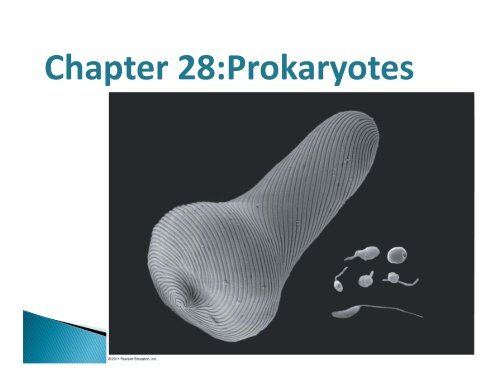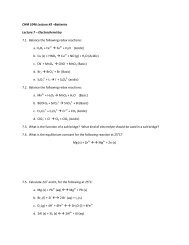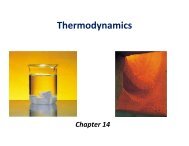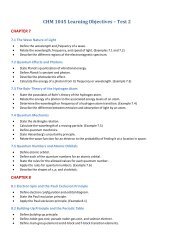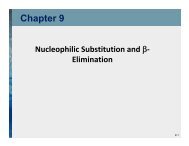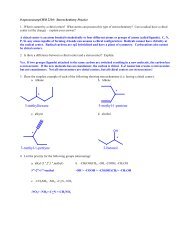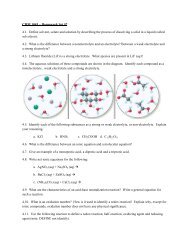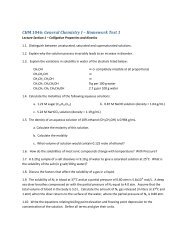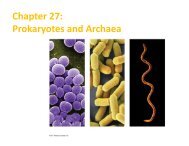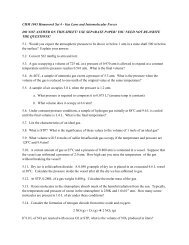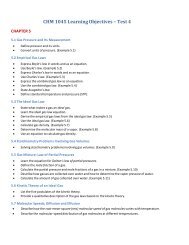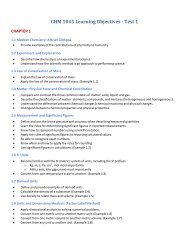Chapter 28 - Protists
Chapter 28 - Protists
Chapter 28 - Protists
Create successful ePaper yourself
Turn your PDF publications into a flip-book with our unique Google optimized e-Paper software.
<strong>Chapter</strong> <strong>28</strong>:Prokaryotes
Protist is the informal name of the group of mostly<br />
unicellular eukaryotes<br />
Advances in eukaryotic systematics have caused the<br />
classification of protists to change significantly<br />
<strong>Protists</strong> constitute a polyphyletic group, and Protista is<br />
no longer valid as a kingdom
<strong>Protists</strong> are eukaryotes<br />
◦ Eukaryotic cells have organelles and are more complex than<br />
prokaryotic cells<br />
◦ Most protists are unicellular, but there are some colonial and<br />
multicellular species
<strong>Protists</strong> exhibit more structural and functional diversity than any<br />
other group of eukaryotes<br />
Single‐celled protists can be very complex, as all biological<br />
functions are carried out by organelles in each individual cell<br />
<strong>Protists</strong>, the most nutritionally diverse of all eukaryotes, include:<br />
◦ Photoautotrophs, which contain chloroplasts<br />
◦ Heterotrophs, which absorb organic molecules or ingest<br />
larger food particles<br />
◦ Mixotrophs, which combine photosynthesis and<br />
heterotrophic nutrition<br />
Some protists reproduce asexually, while others reproduce<br />
sexually, or by the sexual processes of meiosis and fertilization
There is now considerable evidence that much protist<br />
diversity has its origins in endosymbiosis<br />
Endosymbiosis is the process in which a unicellular<br />
organism engulfs another cell, which becomes an<br />
endosymbiont and then organelle in the host cell<br />
◦ Mitochondria evolved by endosymbiosis of an aerobic<br />
prokaryote<br />
◦ Plastids evolved by endosymbiosis of a photosynthetic<br />
cyanobacterium
Plastid<br />
Dinoflagellates<br />
Cyanobacterium<br />
Membranes<br />
are represented<br />
as dark lines in<br />
the cell.<br />
Red alga<br />
Secondary<br />
endosymbiosis<br />
Apicomplexans<br />
1 2 3<br />
Primary<br />
endosymbiosis<br />
Stramenopiles<br />
Heterotrophic<br />
eukaryote<br />
One of these<br />
membranes was<br />
lost in red and<br />
green algal<br />
descendants.<br />
Secondary<br />
endosymbiosis<br />
Secondary<br />
endosymbiosis<br />
Plastid<br />
Euglenids<br />
Green alga<br />
Chlorarachniophytes
It is no longer thought that amitochondriates (lacking<br />
mitochondria) are the oldest lineage of eukaryotes<br />
◦ Many have been shown to have mitochondria and have been<br />
reclassified<br />
The understanding of the relationships among protist<br />
groups continues to change rapidly<br />
One hypothesis divides all eukaryotes (including<br />
protists) into five supergroups
Alveolates Stramenopiles<br />
Amoebozoans Opisthokonts<br />
Green<br />
algae<br />
Diplomonads<br />
Parabasalids<br />
Euglenozoans<br />
Dinoflagellates<br />
Apicomplexans<br />
Ciliates<br />
Diatoms<br />
Golden algae<br />
Brown algae<br />
Oomycetes<br />
Cercozoans<br />
Forams<br />
Radiolarians<br />
Red algae<br />
Chlorophytes<br />
Charophytes<br />
Land plants<br />
Slime molds<br />
Gymnamoebas<br />
Entamoebas<br />
Nucleariids<br />
Fungi<br />
Choanoflagellates<br />
Animals<br />
Excavata Chromalveolata Rhizaria Archaeplastida Unikonta<br />
The plastid‐bearing lineage of<br />
protists evolved into red and<br />
green algae<br />
The DNA of plastid genes in red<br />
algae and green algae closely<br />
resemble the DNA of<br />
cyanobacteria<br />
On several occasions during<br />
eukaryotic evolution, red and<br />
green algae underwent<br />
secondary endosymbiosis, in<br />
which they were ingested by a<br />
heterotrophic eukaryote
5 m<br />
Giardia intestinalis, a diplomonad<br />
parasite
Diatom diversity<br />
50 m
100 m<br />
Globigerina, a foram in the supergroup Rhizaria
20 m<br />
50 m<br />
Volvox, a colonial freshwater green alga
100 m<br />
A unikont amoeba
The clade Excavata is characterized by its cytoskeleton<br />
Some members have a feeding groove<br />
This controversial group includes the diplomonads,<br />
parabasalids, and euglenozoans
Kinetoplastids<br />
Euglenids<br />
Diplomonads<br />
Parabasalids<br />
Euglenozoans<br />
Excavata<br />
Chromalveolata<br />
Rhizaria<br />
Archaeplastida<br />
Unikonta
These two groups lack plastids, have modified<br />
mitochondria, and most live in anaerobic environments<br />
Diplomonads<br />
◦ Have modified mitochondria called mitosomes<br />
◦ Derive energy from anaerobic biochemical pathways<br />
◦ Have two equal‐sized nuclei and multiple flagella<br />
◦ Are often parasites, for example, Giardia intestinalis<br />
(also known as Giardia lamblia)<br />
Parabasalids<br />
◦ Have reduced mitochondria called hydrogenosomes<br />
that generate some energy anaerobically<br />
◦ Include Trichomonas vaginalis, the pathogen that<br />
causes yeast infections in human females
Flagella<br />
5 m<br />
Undulating<br />
membrane
Euglenozoa is a diverse clade that includes predatory<br />
heterotrophs, photosynthetic autotrophs, and<br />
parasites<br />
The main feature distinguishing them as a clade is a<br />
spiral or crystalline rod of unknown function inside<br />
their flagella<br />
This clade includes the kinetoplastids and euglenids
Flagella<br />
0.2 m<br />
8 m<br />
Crystalline rod<br />
(cross section)<br />
Ring of microtubules<br />
(cross section)
Kinetoplastids have a single mitochondrion with an<br />
organized mass of DNA called a kinetoplast<br />
◦ They include free‐living consumers of prokaryotes in<br />
freshwater, marine, and moist terrestrial ecosystems<br />
◦ This group includes Trypanosoma, which causes sleeping<br />
sickness in humans<br />
◦ Another pathogenic trypanosome causes Chagas’ disease<br />
9 m
Trypanosomes evade immune responses by switching<br />
surface proteins<br />
A cell produces millions of copies of a single protein<br />
The next generation produces millions of copies of a<br />
different protein<br />
These frequent changes prevent the host from<br />
developing immunity
Euglenids have one or two flagella that emerge from a<br />
pocket at one end of the cell<br />
◦ Some species can be both autotrophic and heterotrophic
Video: Euglena
Video: Euglena Motion
Long flagellum<br />
Eyespot<br />
Short flagellum<br />
Contractile vacuole<br />
Light<br />
detector<br />
Nucleus<br />
Chloroplast<br />
Euglena (LM)<br />
5 m<br />
Plasma membrane<br />
Pellicle
Some data suggest that the clade Chromalveolata is<br />
monophyletic and originated by a secondary<br />
endosymbiosis event<br />
◦ The proposed endosymbiont is a red alga<br />
◦ This clade is controversial and includes the alveolates and the<br />
stramenopiles
Dinoflagellates<br />
Apicomplexans<br />
Ciliates<br />
Diatoms<br />
Golden algae<br />
Brown algae<br />
Oomycetes<br />
Alveolates<br />
Stramenopiles<br />
Excavata<br />
Chromalveolata<br />
Rhizaria<br />
Archaeplastida<br />
Unikonta
Members of the clade Alveolata have membranebounded<br />
sacs (alveoli) just under the plasma<br />
membrane<br />
◦ The function of the alveoli is unknown<br />
The alveolates include<br />
◦ Dinoflagellates<br />
◦ Apicomplexans<br />
◦ Ciliates
Flagellum<br />
Alveoli<br />
Alveolate<br />
0.2 m
Dinoflagellates have two flagella and each cell is<br />
reinforced by cellulose plates<br />
They are abundant components of both marine and<br />
freshwater phytoplankton<br />
They are a diverse group of aquatic phototrophs,<br />
mixotrophs, and heterotrophs<br />
Toxic “red tides” are caused by dinoflagellate blooms
Video: Dinoflagellate
Flagella<br />
3 m
Apicomplexans are parasites of animals, and some<br />
cause serious human diseases<br />
◦ They spread through their host as infectious cells called<br />
sporozoites<br />
◦ One end, the apex, contains a complex of organelles<br />
specialized for penetrating host cells and tissues<br />
Most have sexual and asexual stages that require two<br />
or more different host species for completion
The apicomplexan Plasmodium is the<br />
parasite that causes malaria<br />
◦ Plasmodium requires both mosquitoes and<br />
humans to complete its life cycle<br />
◦ Approximately 900,000 people die each year<br />
from malaria<br />
◦ Efforts are ongoing to develop vaccines that<br />
target this pathogen<br />
Merozoite<br />
Apex<br />
Red blood<br />
cell<br />
0.5 m
Inside human<br />
Merozoite<br />
Liver<br />
Liver<br />
cell<br />
Apex<br />
Merozoite<br />
(n)<br />
Red blood<br />
cell<br />
0.5 m<br />
Red blood<br />
cells<br />
Gametocytes<br />
(n)<br />
Key<br />
Haploid (n)<br />
Diploid (2n)
Inside mosquito<br />
Inside human<br />
Merozoite<br />
Liver<br />
Liver<br />
cell<br />
Apex<br />
Zygote<br />
(2n)<br />
Merozoite<br />
(n)<br />
Red blood<br />
cells<br />
Red blood<br />
cell<br />
0.5 m<br />
FERTILIZATION<br />
Gametes<br />
Gametocytes<br />
(n)<br />
Key<br />
Haploid (n)<br />
Diploid (2n)
Inside mosquito<br />
Inside human<br />
Sporozoites<br />
(n)<br />
Liver<br />
Merozoite<br />
Liver<br />
cell<br />
Oocyst<br />
Apex<br />
MEIOSIS<br />
Merozoite<br />
(n)<br />
Red blood<br />
cell<br />
0.5 m<br />
Zygote<br />
(2n)<br />
Red blood<br />
cells<br />
FERTILIZATION<br />
Gametes<br />
Gametocytes<br />
(n)<br />
Key<br />
Haploid (n)<br />
Diploid (2n)
Merozoite<br />
Apex<br />
Red blood<br />
cell<br />
0.5 m
Ciliates, a large varied group of protists, are named for<br />
their use of cilia to move and feed<br />
◦ They have large macronuclei and small micronuclei<br />
Genetic variation results from conjugation, in which<br />
two individuals exchange haploid micronuclei<br />
◦ Conjugation is a sexual process, and is separate from<br />
reproduction, which generally occurs by binary fission
Contractile<br />
vacuole<br />
Oral groove<br />
50 m<br />
Cilia<br />
Cell mouth<br />
Micronucleus<br />
Macronucleus<br />
Food vacuoles<br />
(a) Feeding, waste removal, and water balance<br />
MEIOSIS<br />
Key<br />
Conjugation<br />
Asexual<br />
reproduction<br />
Compatible<br />
mates<br />
Diploid<br />
micronucleus<br />
The original<br />
macronucleus<br />
disintegrates.<br />
Diploid<br />
micronucleus<br />
Haploid<br />
micronucleus<br />
MICRONUCLEAR<br />
FUSION<br />
(b) Conjugation and reproduction
Video: Paramecium Cilia
Video: Paramecium Vacuole
Video: Vorticella Cilia
Video: Vorticella Detail
Video: Vorticella Habitat
The clade Stramenopila includes important<br />
phototrophs as well as several clades of heterotrophs<br />
◦ Stramenopiles include diatoms, golden algae, brown algae,<br />
and oomycetes<br />
◦ Most have a “hairy” flagellum paired with a “smooth”<br />
flagellum<br />
Smooth<br />
flagellum<br />
Hairy<br />
flagellum<br />
5 m
Diatoms are unicellular algae with a unique two‐part,<br />
glass‐like wall of hydrated silica<br />
Diatoms usually reproduce asexually, and occasionally<br />
sexually<br />
40 m
Diatoms are a major component of phytoplankton and<br />
are highly diverse<br />
◦ Fossilized diatom walls compose much of the sediments<br />
known as diatomaceous earth<br />
◦ After a diatom population has bloomed, many dead<br />
individuals fall to the ocean floor undecomposed<br />
◦ This removes carbon dioxide from the atmosphere and<br />
“pumps” it to the ocean floor
Video: Diatoms Moving
Video: Various Diatoms
Golden algae are named for their color, which results<br />
from their yellow and brown carotenoids<br />
◦ The cells of golden algae are typically biflagellated, with both<br />
flagella near one end<br />
◦ All golden algae are photosynthetic, and some are mixotrophs<br />
◦ Most are unicellular, but some are colonial
Flagellum<br />
Outer container<br />
Living cell<br />
25 m
Brown algae are the largest and most complex<br />
algae<br />
◦ All are multicellular, and most are marine<br />
◦ Include many species commonly called “seaweeds”<br />
◦ Have the most complex multicellular anatomy of all<br />
algae<br />
◦ Some are giants (up to 100s m long and 2m wide)<br />
The algal body is plantlike but lacks true roots, stems,<br />
and leaves and is called a thallus<br />
The rootlike holdfast anchors the stemlike stipe, which<br />
in turn supports the leaflike blades
Blade<br />
Stipe<br />
Holdfast
A variety of life cycles have evolved among the<br />
multicellular algae<br />
The most complex life cycles include an alternation of<br />
generations, the alternation of multicellular haploid and<br />
diploid forms<br />
Heteromorphic generations are structurally different, while<br />
isomorphic generations look similar<br />
The diploid sporophyte produces haploid flagellated spores<br />
called zoospores<br />
◦ The zoospores develop into haploid male and female<br />
gametophytes, which produce gametes<br />
◦ Fertilization of gamates results in a diploid zygote, which grows<br />
into a new sporophyte
Key<br />
Haploid (n)<br />
Diploid (2n)<br />
Sporangia<br />
10 cm<br />
Sporophyte<br />
(2n)<br />
Zoospore<br />
MEIOSIS<br />
Female<br />
Gametophytes<br />
(n)<br />
Egg<br />
Male<br />
Sperm
Key<br />
Haploid (n)<br />
Diploid (2n)<br />
Sporangia<br />
10 cm<br />
Sporophyte<br />
(2n)<br />
Zoospore<br />
MEIOSIS<br />
Mature female<br />
gametophyte<br />
(n)<br />
Developing<br />
sporophyte<br />
Zygote<br />
(2n)<br />
FERTILIZATION<br />
Egg<br />
Female<br />
Gametophytes<br />
(n)<br />
Sperm<br />
Male
Oomycetes include water molds, white rusts, and downy<br />
mildews<br />
◦ They were once considered fungi based on morphological studies<br />
Most oomycetes are decomposers or parasites<br />
They have filaments (hyphae) that facilitate nutrient<br />
uptake<br />
Their ecological impact can be great, as in potato blight<br />
caused by Phytophthora infestans
Germ tube<br />
Cyst<br />
Zoospore<br />
(2n)<br />
Hyphae<br />
ASEXUAL<br />
REPRODUCTION<br />
Zoosporangium<br />
(2n)<br />
Key<br />
Haploid (n)<br />
Diploid (2n)
Cyst<br />
Germ tube<br />
Hyphae<br />
ASEXUAL<br />
REPRODUCTION<br />
MEIOSIS<br />
Oogonium<br />
Egg nucleus<br />
(n) Antheridial<br />
hypha with<br />
sperm nuclei<br />
(n)<br />
Zoospore<br />
(2n)<br />
Zoosporangium<br />
(2n)<br />
Key<br />
Haploid (n)<br />
Diploid (2n)
Cyst<br />
Germ tube<br />
Hyphae<br />
ASEXUAL<br />
REPRODUCTION<br />
MEIOSIS<br />
Oogonium<br />
Egg nucleus<br />
(n) Antheridial<br />
hypha with<br />
sperm nuclei<br />
(n)<br />
Zoospore<br />
(2n)<br />
Zoosporangium<br />
(2n)<br />
Zygote<br />
germination<br />
SEXUAL<br />
REPRODUCTION<br />
FERTILIZATION<br />
Zygotes<br />
(oospores)<br />
(2n)<br />
Key<br />
Haploid (n)<br />
Diploid (2n)
Video: Water Mold Oogonium
DNA evidence supports Rhizaria as a monophyletic clade<br />
Amoebas move and feed by pseudopodia; some but not all<br />
belong to the clade Rhizaria<br />
Rhizarians include radiolarians, forams, and cercozoans<br />
Excavata<br />
Chromalveolata<br />
Radiolarians<br />
Foraminiferans<br />
Cercozoans<br />
Rhizaria<br />
Archaeplastida<br />
Unikonta
Marine protists called radiolarians have tests fused<br />
into one delicate piece, usually made of silica<br />
◦ Radiolarians use their pseudopodia to engulf microorganisms<br />
through phagocytosis<br />
◦ The pseudopodia of radiolarians radiate from the central body<br />
Pseudopodia<br />
200 m
Foraminiferans, or forams, are named for porous,<br />
generally multichambered shells, called tests<br />
Pseudopodia extend through the pores in the test<br />
Foram tests in marine sediments form an extensive<br />
fossil record<br />
Many forams have endosymbiotic algae
Cercozoans include most amoeboid and flagellated<br />
protists with threadlike pseudopodia<br />
They are common in marine, freshwater, and soil<br />
ecosystems<br />
Most are heteroptrophs, including parasites and<br />
predators
Paulinella chromatophora is an autotroph with a<br />
unique photosynthetic structure<br />
This structure evolved from a different cyanobacterium<br />
than the plastids of other photosynthetic eukaryotes<br />
Chromatophore<br />
5 m
Over a billion years ago, a heterotrophic protist<br />
acquired a cyanobacterial endosymbiont<br />
The photosynthetic descendants of this ancient protist<br />
evolved into red algae and green algae<br />
Land plants are descended from the green algae<br />
Archaeplastida is the supergroup that includes red<br />
algae, green algae, and land plants
Chlorophytes<br />
Charophytes<br />
Red algae<br />
Green algae<br />
Land plants<br />
Excavata<br />
Chromalveolata<br />
Rhizaria<br />
Archaeplastida<br />
Unikonta
Red algae are reddish in color due to an accessory<br />
pigment called phycoerythrin, which masks the green<br />
of chlorophyll<br />
The color varies from greenish‐red in shallow water to<br />
dark red or almost black in deep water<br />
Red algae are usually multicellular; the largest are<br />
seaweeds<br />
Red algae are the most abundant large algae in coastal<br />
waters of the tropics
Bonnemaisonia<br />
hamifera<br />
20 cm<br />
8 mm<br />
Dulse (Palmaria palmata)<br />
Nori
Bonnemaisonia<br />
hamifera<br />
8 mm
Dulse (Palmaria<br />
palmata)<br />
20 cm
Nori
Nori
Nori
Green algae are named for their grass‐green<br />
chloroplasts<br />
Plants are descended from the green algae<br />
Green algae are a paraphyletic group<br />
The two main groups are chlorophytes and<br />
charophyceans<br />
Charophytes are most closely related to land<br />
plants
Most chlorophytes live in fresh water, although<br />
many are marine<br />
Other chlorophytes live in damp soil, as<br />
symbionts in lichens, or in snow
Larger size and greater complexity evolved in<br />
chlorophytes by<br />
1. The formation of colonies from individual cells<br />
2. The formation of true multicellular bodies by cell<br />
division and differentiation (e.g., Ulva)<br />
3. The repeated division of nuclei with no<br />
cytoplasmic division (e.g., Caulerpa)
2 cm<br />
(a) Ulva, or sea lettuce<br />
(b) Caulerpa, an<br />
intertidal<br />
chlorophyte
Video: Volvox Colony
Video: Volvox Daughter
Video: Volvox Female Spheroid
Video: Volvox Flagella
Video: Volvox Inversion 1
Video: Volvox Inversion 2
Video: Volvox Sperm and Female
Most chlorophytes have complex life cycles with both<br />
sexual and asexual reproductive stages
Video: Chlamydomonas
Flagella<br />
1 m<br />
<br />
Cell wall<br />
<br />
Gamete<br />
(n)<br />
<br />
<br />
Nucleus<br />
Cross<br />
section of<br />
cup-shaped<br />
chloroplast<br />
(TEM)<br />
Zoospore<br />
ASEXUAL<br />
REPRODUCTION<br />
Mature cell<br />
(n)<br />
SEXUAL<br />
REPRODUCTION<br />
FERTILIZATION<br />
Zygote<br />
(2n)<br />
<br />
<br />
Key<br />
<br />
<br />
MEIOSIS<br />
Haploid (n)<br />
Diploid (2n)
The supergroup Unikonta includes animals, fungi, and<br />
some protists<br />
◦ This group includes two clades: the amoebozoans and the<br />
opisthokonts (animals, fungi, and related protists)<br />
◦ The root of the eukaryotic tree remains controversial<br />
◦ It is unclear whether unikonts separated from other<br />
eukaryotes relatively early or late
Amoebozoans<br />
Nucleariids<br />
Fungi<br />
Choanoflagellates<br />
Animals<br />
Excavata<br />
Chromalveolata<br />
Rhizaria<br />
Archaeplastida<br />
Unikonta
RESULTS<br />
Choanoflagellates<br />
Common<br />
ancestor<br />
of all<br />
eukaryotes<br />
DHFR-TS<br />
gene<br />
fusion<br />
Animals<br />
Fungl<br />
Amoebozoans<br />
Diplomonads<br />
Euglenozoans<br />
Alveolates<br />
Stramenopiles<br />
Rhizarians<br />
Red algae<br />
Green algae<br />
Plants<br />
Unikonta<br />
Excavata<br />
Chromalveolata<br />
Rhizaria<br />
Archaeplastida
Amoebozoans are amoeba that have lobe‐ or tubeshaped,<br />
rather than threadlike, pseudopodia<br />
They include slime molds, gymnamoebas, and<br />
entamoebas
Slime molds, or mycetozoans, were once thought to be<br />
fungi<br />
Molecular systematics places slime molds in the clade<br />
Amoebozoa<br />
Many species of plasmodial slime molds are brightly<br />
pigmented, usually yellow or orange
Video: Plasmodial Slime Mold
Video: Plasmodial Slime Mold Streaming
4 cm<br />
FERTILIZATION<br />
Zygote<br />
(2n)<br />
Feeding<br />
plasmodium<br />
Mature<br />
plasmodium<br />
(preparing to fruit)<br />
Flagellated<br />
cells<br />
(n)<br />
Amoeboid cells<br />
(n)<br />
Germinating<br />
spore<br />
Spores<br />
(n)<br />
Mature<br />
sporangium<br />
Young<br />
sporangium<br />
MEIOSIS<br />
1 mm<br />
Stalk<br />
Key<br />
Haploid (n)<br />
Diploid (2n)
At one point in the life cycle, plasmodial slime molds<br />
form a mass called a plasmodium (not to be confused<br />
with malarial Plasmodium)<br />
◦ The plasmodium is not multicellular<br />
◦ It is undivided by plasma membranes and contains many<br />
diploid nuclei<br />
◦ It extends pseudopodia through decomposing material,<br />
engulfing food by phagocytosis
Cellular slime molds form multicellular aggregates in<br />
which cells are separated by their membranes<br />
Cells feed individually, but can aggregate to form a<br />
fruiting body<br />
Dictyostelium discoideum is an experimental model for<br />
studying the evolution of multicellularity
600 m<br />
Spores<br />
(n)<br />
Emerging<br />
amoeba<br />
(n)<br />
Solitary<br />
amoebas (n)<br />
FERTILIZATION<br />
Zygote<br />
SEXUAL<br />
(2n)<br />
REPRODUCTION<br />
MEIOSIS<br />
Fruiting<br />
bodies<br />
(n)<br />
ASEXUAL<br />
REPRODUCTION<br />
Amoebas (n)<br />
Aggregated<br />
amoebas<br />
Migrating<br />
aggregate<br />
200 m<br />
Key<br />
Haploid (n)<br />
Diploid (2n)
Gymnamoebas are common unicellular amoebozoans<br />
in soil as well as freshwater and marine environments<br />
Most gymnamoebas are heterotrophic and actively<br />
seek and consume bacteria and other protists
Video: Amoeba
Video: Amoeba Pseudopodia
Entamoebas are parasites of vertebrates and<br />
some invertebrates<br />
Entamoeba histolytica causes amebic dysentery,<br />
the third‐leading cause of human death due to<br />
eukaryotic parasites<br />
Opisthokonts include animals, fungi, and several<br />
groups of protists
<strong>Protists</strong> are found in diverse aquatic environments<br />
<strong>Protists</strong> often play the role of symbiont or producer<br />
Some protist symbionts benefit their hosts<br />
◦ Dinoflagellates nourish coral polyps that build reefs<br />
◦ Wood‐digesting protists digest cellulose in the gut of<br />
termites
10 m
Some protists are parasitic<br />
◦ Plasmodium causes malaria<br />
◦ Pfiesteria shumwayae is a dinoflagellate that causes<br />
fish kills<br />
◦ Phytophthora ramorum causes sudden oak death
Many protists are important producers that obtain<br />
energy from the sun<br />
◦ In aquatic environments, photosynthetic protists and<br />
prokaryotes are the main producers and are limited by<br />
nutrients<br />
◦ These populations can explode when limiting nutrients are<br />
added
Other<br />
consumers<br />
Herbivorous<br />
plankton<br />
Carnivorous<br />
plankton<br />
Prokaryotic<br />
producers<br />
Protistan<br />
producers


